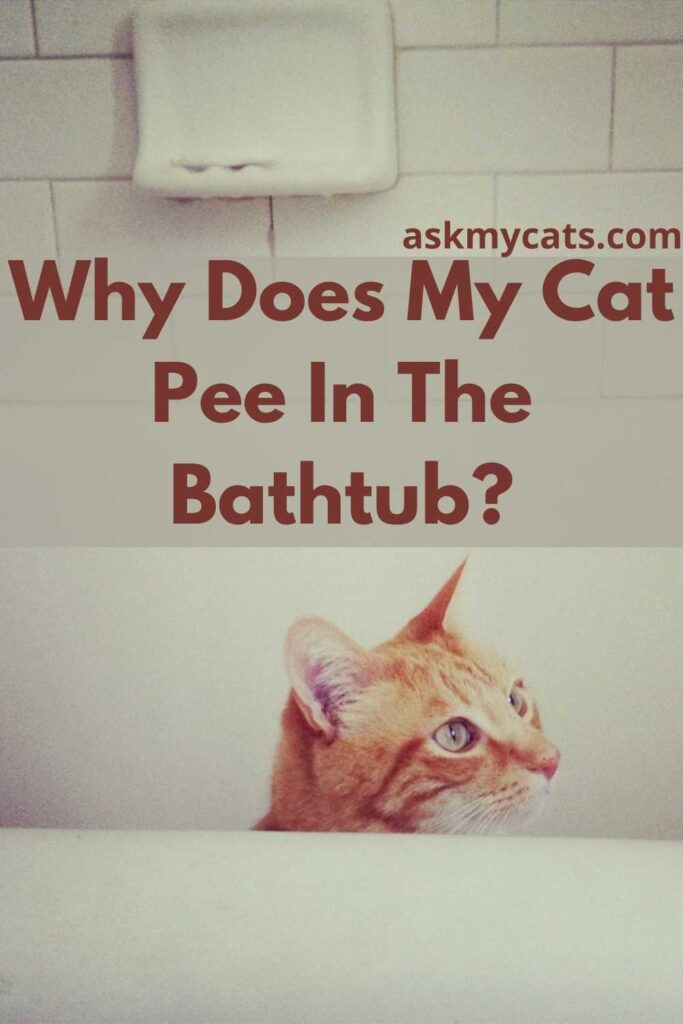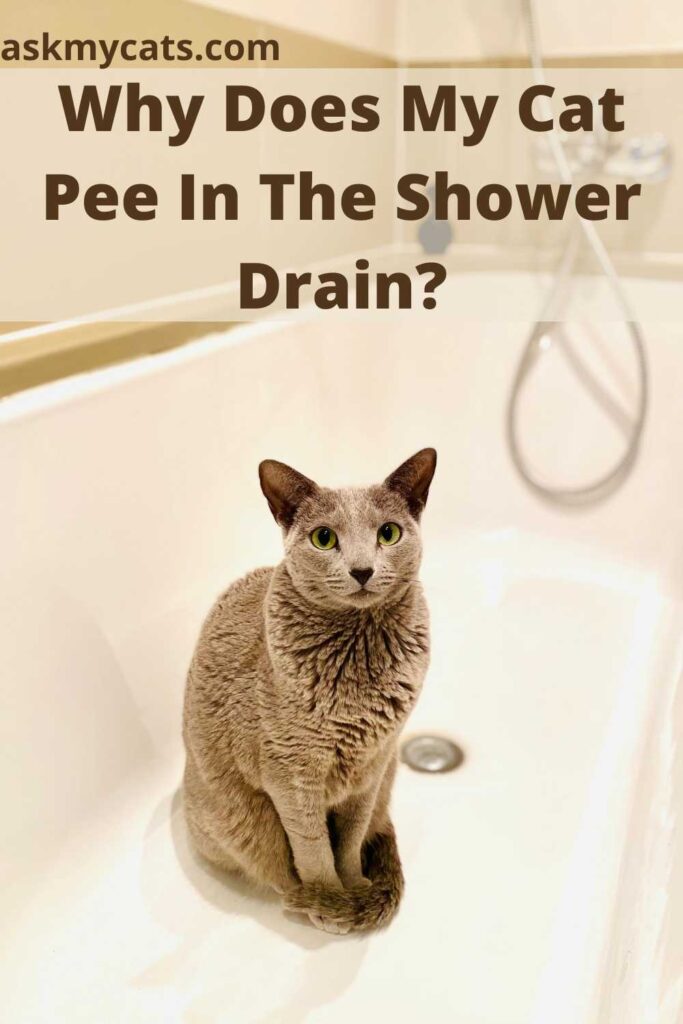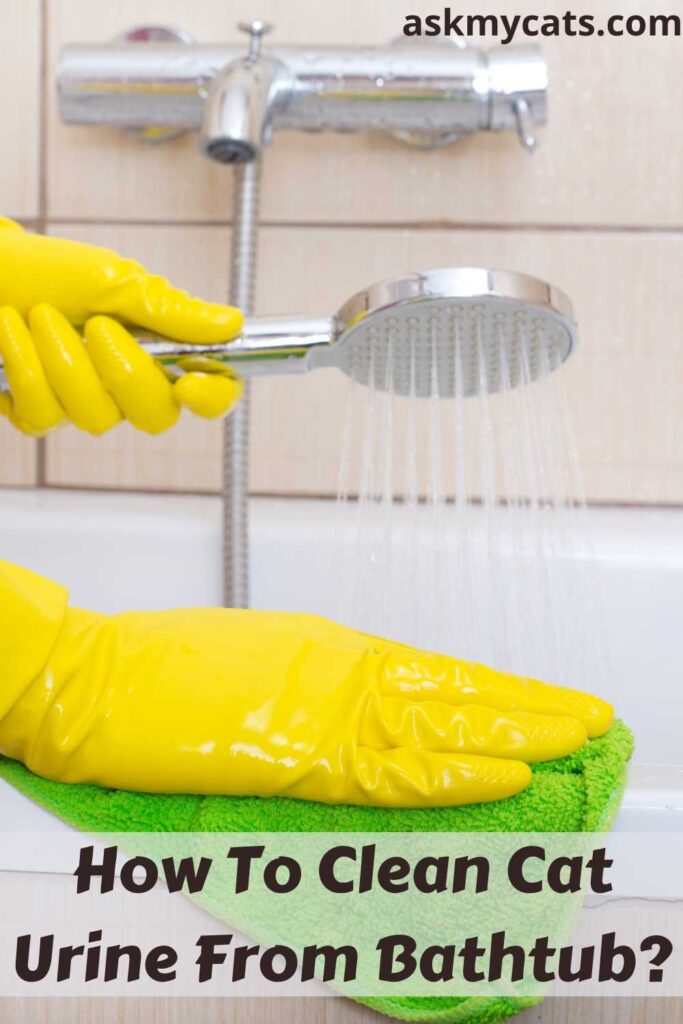Bathtubs appear to be odd places for a cat to want to hang around in. Many cats, on the other hand, prefer to spend their time there, or even in the shower.
This conduct may or may not be alarming. But when your cat starts peeing in the bathtub, you know you’ve got a problem.
So, what is the reason behind your cat peeing in the bathtub?
A cat may begin peeing in the bathtub if they’re dealing with a physical or mental issue. Your veterinarian will need to examine them to rule out any problems that require treatment. If your veterinarian has given your cat a clean bill of health, it’s possible that they’re peeing in the bathtub because they’re unhappy with their litter box situation.
Keep reading this article to know all the reasons behind your cat peeing in the bathtub and how you can stop them.


Give Your Cat the Perfect Day
Get the Free Ebook!
Why Does My Cat Pee In The Bathtub?
Here are some reasons why your cat may be peeing in the bathtub: –

1. Physical Problem
A physical health issue is the first thing to rule out, especially if your cat has suddenly started peeing in the bathtub.
They could be suffering from a urinary tract infection, kidney illness, or a blockage of some sort.
Why did they choose the bathtub over the litter box?
They may have had pain while using their litter box, and they now associate that pain with the litter box, which they wish to avoid.
Or cats may need to pee and not have enough time to get to their litter box, especially if it’s on a different level of the house, so they use the bathtub as a huge litter box.
It might be painful for a cat to have difficulty peeing due to arthritis, a UTI, a bladder stone, cystitis, or another health issue.
If a cat experiences pain while using the litter box, even if the cat is not currently ill, the cat may link the litter box with the discomfort.
Cats that are shocked or scared when in the litter box behave similarly. This can happen if a cat is startled by a youngster or another pet while attempting to use the litter box.
Although some cats are more susceptible to UTIs than others, these diseases can affect any cat.
Inappropriate urination is common in cats with UTIs due to discomfort, agony, or a general feeling of needing to go potty all the time. If the UTI has progressed, the urine may have a strong odor.
UTIs are normally easy to treat with veterinarian help, however, some are more difficult to treat than others.
Some cats may need permanent dietary adjustments to help preserve urinary tract health, while others may require special diagnostics to get them on the correct antibiotics to address the bacteria that is causing the infection.
Peeing in the tub can be a cat’s way of requesting assistance. Cystitis, bladder stones, urinary tract infections, and kidney infections can all make a cat feel sick, make it difficult to urinate, and make it avoid places where it would typically urinate.
However, it could also be attempting to attract your attention and alert you to the fact that anything is amiss.
Cats, especially senior cats, are prone to kidney illness. It’s a treatable condition, but renal disease in cats, like in people, occurs in varying degrees of severity as the kidneys deteriorate and shut down. Your cat’s kidney ailment will eventually kill him.
Kidney disease management choices can help cats live longer and stay healthy, especially if the condition is diagnosed early.
It’s a good idea to rule out kidney illness as a cause if your cat suddenly starts peeing in the bathtub.
If your cat is straining to pee or showing signs of pain, you should take them to the veterinarian right once.
They’ll be able to check for any health conditions that could be causing them to pee in the tub.
Also, read the possible reasons for cat peeing over edge of litter box
2. Mental Issue
Cat owners frequently struggle to understand their pets’ behavior, and it can be tough to tell when your cat is upset.
Cats dislike disrupting their daily routines, and a sudden shift can have a huge impact on their behavior.
If you’ve recently relocated or just returned from a long vacation, your cat may urinate in unusual areas, such as the bathtub.
Returning from a holiday or unpacking in a new house can be stressful for cat parents. When you’re busy, it’s easy to forget to provide your cat love and attention, but it’s critical to continue to play with your cat and build a routine to reduce stress levels.
You can also talk to your veterinarian about utilizing soothing medicines like melatonin to help the animal relax.
Cats, like humans, can cope with stress and worry. Even the tiniest change in their environment, such as changing their litter box or litter, moving their furniture, or obtaining a new roommate, might cause them discomfort.
There are a number of factors that could be causing your cat to go pee in the bathtub.
Because cats are incredibly sensitive creatures, it can be difficult to pinpoint the source of the stress, as it could be something you didn’t expect to be upsetting, such as a new piece of furniture or rearranging your home’s contents.
Cats, on the other hand, can suffer from a chemical imbalance that produces unusual behavior.
Talk to your veterinarian about mood medication possibilities if your cat doesn’t have a health problem and nothing has changed recently that could cause them upset.
3. Litter Box Issue
The litter box itself is a common cause of a cat peeing outside the litter box.
It might be that it hasn’t been maintained clean enough, that odors have developed, that your cat doesn’t like the new litter you bought, that they don’t like the placement, style (covered, top-entry), or size of the litter box…the list goes on.
It’s possible that something you’ve recently altered in and/or around your cat’s litter box is causing them to seek refuge in the bathtub.
Your cat’s preferences may have just changed, and they’ve decided they won’t put up with a little dirty litter box any longer, or that they don’t enjoy their litter.
Cats, like people, prefer to use a clean bathroom. A dirty litter box is one of the most prevalent reasons for a cat to pee in a bathtub.
The litter may be old and used, the box may be burdened by clumps of urine and feces, or the plastic box itself may be in need of cleaning, causing the cat to refuse to use it.
Covered or enclosed litter boxes, while popular as a means of concealing the litter box, are really deterrents to a cat’s desire to use it.
A cat peeing in a bathtub is a common occurrence when the litter box is changed. Cats have preferences, and some don’t like specific types of litter, particularly perfumed litter. Some cats are very particular about the litter they use.
Perhaps you’ve recently switched to a new kind of litter, or you’re trying scented litter for the first time when your cat is used to unscented litter.
Unfortunately, not all cats will respond to all varieties of cat litter. This isn’t always an easy challenge to solve because figuring out what your cat likes and doesn’t like can take some trial and error.
Your cat will most likely express how much or how little they appreciate the litter you purchased for them.
Due to the time and effort, it may take to discover the appropriate litter for your cat, this can be a difficult solution.
Cats are particular about where they go to the bathroom, so if your litter box isn’t in great real estate (in your kitty’s mind), they may refuse to use it and begin using the bathtub instead.
If your cat’s litter box is in a cold environment, such as a garage, they may not appreciate having to cope with the cold.
If it’s in a laundry room, the loud noises may bother your cat. Litter boxes in high-traffic areas of the house may be too much for your cat to tolerate.
One litter box per cat plus one extra is the typical rule of thumb for litter boxes. If there aren’t enough litter boxes in your home, your cat may begin peeing in the bathtub to express their dissatisfaction with the situation.
Also, make sure your home has a litter box on each level. Some cats may not want to go up and down the stairs every time they need to pee, which might lead to them peeing in unsuitable areas, such as the bathtub.
It can be difficult to find homes for many litter boxes, so get inventive if you need to. Some individuals even install kitty doors to make it easier for their cats to access hidden litter boxes.
Also, check out reasons and solution for cat peeing on bath mat
Why Does My Cat Pee In The Shower Drain?
The reasons behind your cat peeing in the shower drain are: –

1. Scent
Your cat may be sensing their own scent, which informs them it’s time to urinate if the smell of cat urine isn’t being totally removed.
If you have a clog, cat pee scents may be stuck in the drain, or your cat may have sprayed on the shower curtain and wall without your knowledge.
You may not be able to identify the odors, but if they are present, your cat will detect them.
If you use a cleaning that contains ammonia, you may unintentionally be attracting your cat to pee in the shower drain.
Because cat urine contains ammonia, the smell of ammonia can tempt them to urinate in an area where they can leave their scent.
2. Hormones
Spaying or neutering your cat, whether she is a female or a male, is an important treatment that can lower the risks of an escape and prevent your cat from marking away from the litter box.
Males who notice nearby females in heat or females that want to attract males may decide to mark their territory in the shower drain.
Intact males emit a stronger odor when they pee than neutered cats because their hormones are surging.
Take your cat to the veterinarian to get it fixed when it is at least 6 months old. Females’ recovery times are a few days longer than males’. The majority of females recover in 10 to 14 days.
How Do I Stop My Cat From Peeing In The Bathtub?
To stop your cat from peeing in the bathtub, have them examined by a veterinarian to rule out any health issues. Other tips are as follows: –
1. See Your Vet
When your cat exhibits any unusual or new behavior, the first thing you should do is contact your veterinarian.
They are the only ones who can rule out a health problem. It’s also best to discover health problems early.
2. Reduce Stress
If you think a change in your cat’s environment is causing their behavior to change, consider minimizing their tension.
If you’ve just brought a new pet, infant, or roommate into the house, your cat may be feeling neglected.
Increase the amount of time you spend talking, caressing, brushing, or playing with your cat.
Even if you think they already get plenty of attention, there’s no such thing as too much attention from the person they care about the most in their eyes.
3. Positive Reinforcement
Encourage them to use their litter box with positive reinforcement, but don’t make a huge deal if they pee in the bathtub.
If they’re peeing in the bathtub to grab your attention and you react when you notice it, they’ll keep doing it because it works.
They don’t care if the focus is pleasant or negative; all they want is your attention.
The more attention you give them for doing something “good,” such as using their litter box, the less likely they are to engage in “bad” behavior to gain attention.
When they use the litter box, speak to them in a loving, excited tone, and offer them pets and possibly snacks once they’ve finished.
Also, check out how to stop my cat from pooping in the bathtub
How To Clean Cat Urine From Bathtub?
To clean your cat urine from the bathtub use any bathroom cleaner.

The coating of your bathtub prevents water from penetrating the substance, yet odors may remain in the drain.
Your cat’s pee could be stuck under the drain’s edge, or it could be sitting in your drain if you have a clog.
As long as it doesn’t contain ammonia, a simple bathtub cleaner should suffice to clean the tub.
Check for obstructions in your drain to ensure that cat urine is completely washed away.
Make sure to clean the area around the drain as well. If there’s a space between the drain and the tub, use a small scrub brush or even a toothbrush (for domestic cleaning only) to get some cleanser beneath the drain’s rim and make sure cat urine odors aren’t trapped there.
You can also use an enzyme cleaning to ensure that all urine odors are fully gone.
Frequently Asked Questions
Can I use a Phermone diffuser to stop my cat from peeing in the bathtub?
Yes, it is a good idea to use a Phermone diffuser to stop your cat from peeing in the bathroom. The scents are designed to calm your cat and reduce scratching and urine spraying.
How to keep a cat out of a bathtub?
The bathtub is one of the best places for your cat to pee outside of the litter box. Although you don’t want to encourage this behavior, it’s possible that leaving the option open will help them to use their litter box. If you’re confident they won’t use the bathroom elsewhere in the house, you may try filling the bathtub with just enough water to cover the bottom.
Why does a cat pee on the bathmat?
If a cat is suffering from a health problem or is dissatisfied with its litter box, it may pee on a bathmat. It’s possible that their litter box is filthy, and the fluffy bathmat appears to be a suitable alternative. Because their aroma lingers in the mat’s fibers after they pee on it once, they’re likely to do it again. You’ll need to use an enzyme cleaner to get rid of all urine odors, including those only your cat can sense, so they don’t keep picking up on the scent, which informs them it’s time to urinate.
Final Words
It can be an inconvenient and time-consuming situation if your cat has suddenly started peeing in the bathtub. However, there are a variety of factors that could lead to your cat engaging in this activity, so consider all of your choices.
Because the answer is sometimes more evident than others, the beginning point for determining why your cat is doing this and correcting the habit will differ depending on the situation.
If you have any questions, ask us in the comments section.
References
- https://www.vet.cornell.edu/departments-centers-and-institutes/cornell-feline-health-center/health-information/feline-health-topics/feline-behavior-problems-house-soiling
- https://www.aspca.org/pet-care/cat-care/common-cat-behavior-issues/litter-box-problems
- https://www.deseret.com/1999/11/7/19474255/2-easy-ways-to-keep-cat-out-of-tub
